Contents
- 1. Manual 1
- 2. Manual 2
Manual 1
Sidekick LX™
Reference Guide
27-4007-01 Rev. B - R4.4 - July 13, 2007
Copyright © 2007 Danger, Inc. All rights reserved.
-2-
Contents
Welcome! 5
Device Basics 6
Opening and Closing the Display 6
Control Buttons 7
Phone Controls 9
Sound Controls 11
Mini Music Player 11
Volume Controls 12
Wireless On/Off Control 13
Display Controls 13
Battery Charger 14
Removable Battery 15
SIM Card Slot 16
Memory Card Slot 17
USB / Power Port 18
Registration 18
Setting Up Your Device 22
Bluetooth® Technology Setup 22
Backgrounds 23
Font Size 24
Backlighting 24
Key Guard Mode 25
Device Privacy Code 26
Sound Profiles 26
Application Customization 27
The Device Interface 28
The Jump Screen 28
Menus 29
Quick Jump 29
Indicators 30
Type and Edit Text 32
Navigate in Text Boxes 32
Delete Text 32
Cut, Copy, Paste, Undo 32
AutoText 33
Type Special Unicode
Characters 34
-3-
The Desktop Interface 35
Using the Applications 36
myFaves
Add a Contact to myFaves 36
Communicate with a myFaves
Contact 37
Assign an Icon to a myFaves
Contact 38
Replace a myFaves Phone
Number 38
Phone
Make a Phone Call 39
Use Bluetooth Hands-Free Headset
or Car Kit 40
Answer a Phone Call 40
Add a Number to Your Speed Dial
List 41
Check Your Voice Mail 41
Change Your Phone Ringtone 42
Import Contacts from Your SIM
Card 42
Text Messaging
Send a Text Message 43
Picture Messaging
Send a Picture Message 44
Web Browser
Browse the Web 45
Bookmark a Web Page 46
Copy Text on a Web Page 46
Email
Send an Email Message 47
Fetch Email from External
Accounts 48
Fetch Email Using Your Device’s
Web Browser 51
Attach a Photo, Sound, or vCard to
an Email Message 52
Address Book
Add a Contact to the Address
Book 53
Communicate with a Contact 54
-4-
Import Address Book Contacts 55
Set and Send “My vCard” 56
Send any Contact’s vCard 57
Calendar
Add an Event to Calendar 57
Notes
Create a Note 58
Send a Note via Email 59
To Do
Add a Task 59
Camera
Take a Photo 60
Send Photos by Email or Picture
Message 61
Use Photo for Caller ID or Key
Guard Background 61
Music Player
Copy Music to the Memory Card 62
Play Songs 63
Create a Playlist 65
Download Catalog
Download Items from the
Catalog 65
Manage Your Downloaded Items 67
Instant Messaging
Sign On 68
Send an Instant Message 68
Switch Between IM
Conversations 69
Keyboard Shortcuts 70
Troubleshooting 71
Handling and Safety Precautions 76
Regulatory and Compliance
Information 80
Legal Information 84
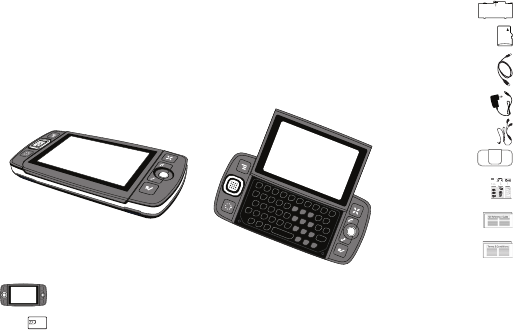
-5-
Welcome!
Thank you for buying a Sidekick LX™ device. Your Sidekick will
change the way you communicate, get organized, and stay
connected.
Here’s what you’ll find in the box:
Sidekick LX™ device
SIM card
Removable battery
microSD™ card
USB cable
Battery charger (wall adapter)
Hands-free stereo headset
Carrying case
1. Insert SIM Card
1Remove the back cover.
• Pressthecoverlatchwithyourleft thumb.
• Pushthecoverrighttorelease.
• Liftthecovertoremoveit.
2Insert your SIM card.
• Goldcontactsfacedown.
• Twobracketsmustbeontopofthe card.
1Insert the battery, top edge first.
2Replace the back cover.
Slidethecoverbacktotheoriginalposition
whilepressingthecoverlatchwithyourleft
thumb.
3Insert the battery charger into the USB
port.
4Let your device charge for at least 4
hours!
5Press the Power button.
2. Insert Battery 3. Register
1Wait for activation.
You’llknowyourdevicehasbeenactivated
whenthisWelcomescreenappears:
2Step through account registration.
Justfollowthepromptsuntilyouseethe
Congratulationsscreen.
3Select the Start button.
TheJumpscreenopens,showingthering
ofapplications.Rollthetrackballtoscroll
throughtheapplications,thenpressthe
trackballtoenteranapplication.Press
toreturntotheJumpscreenatany time.
Indicators and Icons
Wireless Signal Strength Indicator Thenumber
ofsignalbandsshowingtotherightofthe radio tower
iconrepresentsthestrengthofthesignalatyour current
location.
IfyouseeanXflashingovertheradiotower icon,
you’vetemporarilylostnetworkconnectionandcanmake
nocalls.
Service Connectivity Indicators Onedot=
deviceisconnectingtotheGPRS/EDGEnetwork;twodots
=gettingIPaddress;threedots=connectingto the data
service;=fullyconnected to the data service.
Bluetooth Indicator Whenyouseethisiconjustto
theleftofthe, you know that Bluetooth featuresare
available.
GSM (Phone) Service Only Aphoneiconintheplace
ofthe“G”meansyouareusing(oronly have access to)
GSMphoneservice.Ifyouhaveacallin progress you’ll
alsoseeatimer.Ifthephoneiconis hollow, you can only
makeemergencyphonecalls.
Sound Profile Setting Whenyouhavesound
turnedoff(“Silent”soundprofile),thetitlebarwill indicate
whetheryouhaveflashinglightsorvibrationsetfor alerts
ornotifications.Fromlefttoright,theiconsindicate: totally
silent(nosound,noflashinglights,novibration),flashing
lightsonly,andvibrationonly.
D-Pad Light Indicators Duringdevicesleep,thecenter
oftheD-padwillglowablinkingcolor:blue = pending
message,green=normalsleep,red=lowbattery.
TRACKBALL Presstoselectitems on the screen. Roll
thetrackballtonavigatethescreen.
SEND/END CALL buttons Whenthebuttonsarelit,
usethemtosendorendacall.When unlit, press these
buttonstopageup ordown.
DONE button Press togo backthroughscreensyou
werepreviouslyviewing.Onascreenorina dialog box,
pressto save changes.
Device Controls
Using the Applications
Bluetooth
On
Screen
Title
Battery Strength
Wireless Signal
Strength
Date and Time
Service
Connectivity
Status
Sound
Profile
Setting
New Message
Notification
(Email)
Jump Screen
Make a Call
Press,type a
nameornumber,
thenpress.
End a Call
Press.
Answer a Call
Press.
Assign Speed Dial
GotoPhone,press and
selectSettings>Speed
Dial&CallingCards.
Call a Speed Dial Number
Pressandholdspeed
dialnumberusingthe
keyboardordialpad.
Set Up Voice Mail
Pressandholdthe#1key.
Followtheprompts.
Phone Web Browser
Quickly Contact a Contact
1 FromtheAddressBook’s“Browse
Contacts”screen,highlightacontact,then
pressandholdthetrackball.
2 Amenuopensthatlistsallthe
communicationoptionsavailableforthat
contact. Selecttheactionyouwanttotake.
Address Book
Retrieve Messages
Pressandholdthe#1key.
The Contact Details Screen
1 FromtheBrowseContactsscreen,selecta
contacttoopentheirDetailsscreen.Fromthis
screenyoucanviewalltheinformationyou’ve
storedforthatcontact.
2 Simplyselectaphonenumber,email
address,orotherdetailtolauncha
communicationwiththatperson.
Assign a Photo Caller ID Icon
Youcanassignphotoiconsto50of
yourcontacts.
1 FromtheBrowseContactscreen,
selectacontacttoopentheContact
Detailsscreen.
2 SelecttheEditbuttontoopenthe
EditDetailsscreen.
3SelecttheEdit Identitybutton,
thenscrolltohighlighttheicon .
4 Pressthetrackballtoopenthe
listoficons.Select togotothe
Cameraandselectanexistingphoto
orcaptureanewone.
Go to a Web Page
1 StarttypingtheURL.TheGoTo
boxopens.FinishtypingtheURL.
2 Pressthetrackballtogotothe
page.
Change Text Size
Pressand select View > Text
Size.
Create a Bookmark
1 FromtheWebpageyouwant
tobookmark(orfromanypage),
press+ N.
2 Completetheinformationinthe
AddBookmarkdialogbox,then
press.
Sidekick® “Shuriken”
27-4006-01Rev.02.May14,2007
©Danger,Inc.Allrightsreserved.
Get
Started
Change Ringtone
Pressand
selectSettings>
General.
Right Shoulder
Button
Left Shoulder
Button
Power On / Power Off Button
Volume Buttons
D-pad
+-
USB /
Power Port
Headset Jack
Menu Button
Jump Button
Cancel Button
Done Button
Send Call Button
End Call Button
Trackball
Opening & Closing the Display Pressyourleftthumb
onthelower-leftcornerofthedisplayandgently push
upinaclockwisedirection.Thedisplaywillspring
smoothlyintotheopenposition.
Toclosethedisplay,reversethemotiontopivot the
displaycounter-closewise.
CANCEL button Presstodismiss anychangesyou
havemadetoascreenordialogbox.
MENU button Pressto open a list of actions you can
takeonthecurrentscreen.
JUMP button Pressto go directly to the Jump
screen,yourstartingpointforlaunchingallthedevice
applications.
Start Guide
Reference Guide
Limited Warranty (Terms & Conditions)
If any of these items are missing, please contact your T-Mobile
Customer Care department.

-6-
Device Basics
Opening and Closing the Display
To open the display, press your left thumb on the lower-left
corner of the display and gently push up in a clockwise direction.
The display will spring smoothly into the open position.
Alternatively, use your right index finger to push down gently on
the upper-right corner of the display. The screen will spring into
the open position.
The normal operating position of the device is horizontal, with
the trackball on the right, as shown on the left.
To close the display, reverse the motion to pivot the display
counter-clockwise and snap it into the closed position.
! Protect the display from scratches by always using the
carrying case to transport your device.

-7-
Control Buttons
MENU
JUMP
TRACKBALL + SEND/END
CANCEL
DONE
TRACKBALL Press the trackball to select a highlighted item
or press and hold to open a pop-up menu. Roll the trackball to
reverse or advance the current selection through the “selectable”
items on a screen. Rolling the trackball left or right with a folder
highlighted opens/collapses folder contents. Adjust trackball
speed and acceleration from the Jump Menu > Settings >
Trackball & D-Pad screen. Read what the trackball colors mean
during sleep in “Trackball light indicators” on page 31.
SEND/END buttons
When the buttons are lit, use them to send/
end a call. When unlit, press to page up
or to page down.
DONE button Press DONE to go back through the screens
you were previously viewing, until you reach the Jump screen. On
a screen or in a dialog box, press DONE to save your changes
and dismiss the screen or dialog box.
CANCEL button Press CANCEL to dismiss any changes you
have made to a screen or dialog box.
MENU button Press MENU to open a list of actions you can
take on the current screen.
JUMP button Pressing JUMP takes you back to the
Jump screen, your starting point for launching all the device
applications.
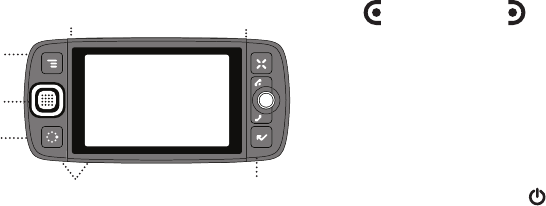
-8-
RIGHT SHOULDER
BUTTON
LEFT SHOULDER
BUTTON
POWER ON / OFF BUTTON
VOLUME BUTTONS
D-PAD
+-
USB /
POWER PORT
HEADSET JACK
DIRECTIONAL PAD (D-Pad) Press up, down, left, or right to
scroll or move within text fields, and navigate in games. By
default, the D-Pad navigates folders and screens, jumping over
individual items. You can make the D-Pad navigate the same
as the trackball (moving item-by-item) from the Jump Menu >
Settings > Trackball & D-Pad settings screen.
LEFT AND RIGHT SHOULDER buttons The function of
these buttons depends on which application you’re using. For
example, while using the Camera, the right shoulder button
captures a photo. While using the Phone, the left shoulder
button toggles Mute and the right shoulder button toggles
Speakerphone. While in the Email and Picture Messaging
compose screens, the right shoulder button opens your photo
albums so you can select a photo to attach to the message, and
the left shoulder button opens the voice recorder.
POWER ON/OFF button Press the Power button for three
seconds to power the device on or off. You can also press the
Power button twice (“double-tap”) to power off.
VOLUME buttons Press and hold + or - to step through your
Sound Profiles or to increase/decrease the volume on the phone
or music player. To silently mute your device, press and hold -.
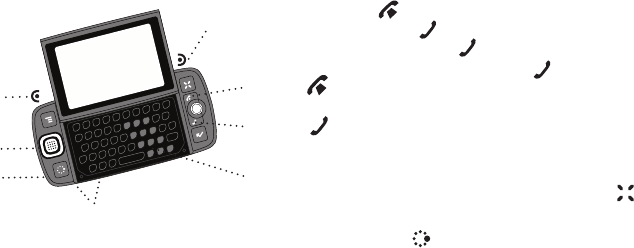
-9-
Phone Controls
SPEAKERPHONE BUTTON
(while on phone)
SPEAKER
VOLUME BUTTONS + -
DIAL PAD
SEND CALL
END CALL
MUTE BUTTON
(while on phone)
HEADSET JACK
DIAL PAD Use the keyboard dial pad to dial a number with one
hand.
END CALL and SEND CALL buttons When the Send and End
buttons are lit, it means you can use them to place a call. Press
to end a call or clear the screen of a number you’ve typed.
Press to call the phone number you’ve typed or highlighted in
a list. Press with no number typed to display a list of recently-
dialed numbers. Press from the Jump screen to open the
Recent list.
SPEAKER When using the device as a handset, place the
speaker, located in the D-Pad, to your ear.
MICROPHONE When you are using the phone, speak into the
microphone, located by the CANCEL button.
VOLUME buttons The volume buttons are located under the
JUMP button. While on a phone call, press + to increase or - to
decrease volume. Use the left and right shoulder buttons to turn
Mute or Speakerphone on and off.

-10-
BLUETOOTH HANDS-FREE HEADSET OR CAR KIT To use a
Bluetooth hands-free headset or car kit, do the following:
1 Press JUMP to go to the Jump screen. Press MENU to open
the menu, then select Bluetooth to open the submenu. Make
sure Bluetooth features are “on”.
2
While you are in your car, make sure your hands-free headset or
car kit is ready to pair by following the manufacturer’s instruc-
tions. On your Sidekick, go into the Phone application. Press
MENU and select Settings > Pairing.
3 From the Pairing dialog box, select your Bluetooth hands-
free headset or car kit from the list of devices (it may take a
few seconds for the list to populate). If prompted, type the
device’s PIN code, then press DONE to dismiss the PIN
Code dialog box.
4 By default, your call’s sound will go through the device
handset. To send or receive your call using a Bluetooth
device, press MENU and select Transfer Sound to, then
select your Bluetooth device from the submenu.
Transfer the call’s sound either before or during a call.
5 Place your call.
6 When finished with your call, press END CALL .
STEREO HEADSET JACK
Always connect your headset to your
device before making/receiving a call.
To use the headset button:
n Press the button once to answer a call and again to end it.
n During a call, press once to answer a second incoming call
and put the first caller on hold.
n
With two callers on the phone, press the button once to end the
active call and press again to resume the on-hold call.
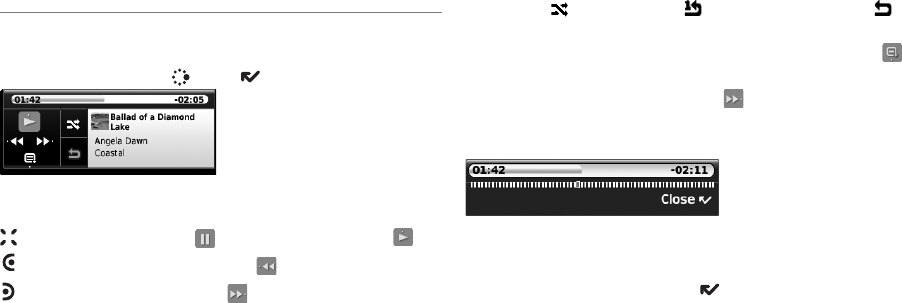
-11-
Sound Controls
Mini Music Player
To open the mini music player (transport controls) from anywhere
on the device, press JUMP + DONE .
Press one of the four sides of the D-Pad, or use the trackball to
select a control. You can also use these shortcuts:
- Pause song now playing , or resume play if paused .
- Play previous song in Play Queue .
- Play next song in Play Queue .
The shuffle and loop icons indicate, when they are green, that
shuffle is on , loop once is on , or loop repeatedly is on .
Select an icon to cycle through settings.
To jump to the Play Queue screen, press the Play Queue icon .
To scroll through the songs in the Play Queue, press the D-Pad
left/right or select the forward control with the trackball.
To go to a specific place in a song
, roll the trackball up, then
select the song progress bar at the top of the player. A slider opens:
The row of bars is referred to as the “scrubber bar”. The
highlighted bar indicates where you are in the currently-playing
song. Roll the trackball right to fast forward, left to rewind. To
close
the scrubber bar, press DONE .

-12-
Volume Controls
There are two ways you can open the volume controls:
nPress MENU + DONE . Roll the trackball left or right to
step through your sound profiles. Left is louder, right is softer.
(Read more in “Sound Profiles” on page 26.)
nPress the + or - volume buttons on the lower-left edge of
your device. Continue pressing the buttons to step through
your sound profiles:
To switch to the “silent” sound profile without making a
sound, hold down the - volume button.
If you are playing a song or on the phone, the volume control
panel includes separate volume controls for the music or phone
call. This control is focused by default; to change your Sound
Profile, roll the trackball down to focus the Sound Profile pane,
then roll the trackball left or right to select a profile.

-13-
Wireless On/Off Control
If you need to turn off your device’s GSM, GPRS, EDGE, and
Bluetooth wireless connectivity (for example, during aircraft
takeoff and landing), do the following:
1 From the Jump screen, press MENU and select Airplane
Mode > Turn Wireless Off.
2 Your device is now offline. Confirm offline status by looking
at the title bar; the radio tower icon and “OFF” should blink
alternately.
3 To turn wireless back on, from the Jump screen, press MENU
and select Airplane Mode > Turn Wireless On.
Display Controls
To adjust the display backlight brightness:
1 Press MENU then select Settings > Battery & Display.
2 Select the Brightness slider to open it for adjustment. By
default, brightness is set to 1/4 of the range, as shown below:
Roll the trackball right to increase brightness; roll left to
decrease.
3 When ready, press the trackball to apply the setting.

-14-
Battery Charger
Your device comes with a removable, rechargeable lithium-ion
battery. When you first receive your device, it is important that
you fully charge the battery, described below.
! Only use the charger and battery provided with your device
or approved by T-Mobile, or you risk damaging your device. Do
not insert battery chargers from previous Sidekick models into
the stereo headset jack.
If you attach your device to your computer via USB, be aware
that the power received may not be enough to charge your
device. For example, when computers are in “sleep” mode,
only a trickle charge may be supplied via USB. In this situation
you can lose more power than you gain.
1 Attach the battery charger to your device.
Locate the battery charger that came in the box with your
device. Insert the charger’s USB lead (plug) into your device’s
USB port. Now plug the power cord into a standard electrical
wall outlet.
An orange charge indicator light will go on and a lightning
bolt icon will appear over the battery icon in the title bar,
indicating the charger is connected and the battery is
charging. Note that if your device has discharged completely,
it may take up to 15 minutes before you see any indication of
charging on the screen.

-15-
2 Let the device charge for at least four (4) hours.
Put the device in a safe place and let the battery charge for at
least four hours with the device powered on.
As the device is charging, the bars in the battery icon fill
repeatedly from left to right. When your device is fully
charged, the lightning bolt icon will disappear and the bars
will stop moving and remain in the filled position.
For efficient operation, charge your device nightly. If you
plan to leave your device unattended for an extended period
of time, be aware that the battery will discharge after two
days if it is turned on and not attached to the charger. If your
device does fully discharge, simply attach it to the charger to
recharge.
Removable Battery
To replace your rechargeable battery, or if you need to insert or
remove your SIM card, first you will need to remove the installed
battery. Begin by powering down your device:
1 Press and hold the power button three seconds to power
down.
2 Turn the device over. With the camera at the top, slide the
cover to the right by carefully pressing the raised line on the
cover with your left thumb. Lift the cover to remove it.
RAISED LINE
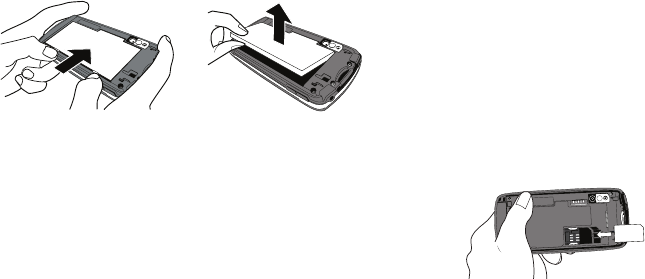
-16-
3 Push the battery in slightly along the bottom edge, then lift
the battery from that same edge to remove it.
4 Replace with a new battery by first inserting the top notched
edge (with the gold contacts) and then pushing the battery
down to lock into place.
5 Replace the cover. Once the battery makes contact, the
power-on sequence begins.
SIM Card Slot
To access your SIM card, you must first remove the battery.
1 Remove the battery cover and battery by following
“Removable Battery”, steps 1-3, on page 15.
2 Notice the SIM card slot, which is shaped like a SIM card and
is located just to the right of center.
3 To insert the SIM card, slide the card into the slot with the
gold contacts facing down and the notched corner at the
upper right. Be sure the two side brackets are on top of the
card, holding the card in place.
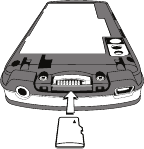
-17-
4
To remove the SIM card, insert your nail or paper clip into the
notch to the left of the card in order to move the card slightly
to the right. Then gently use your finger to slide the card to the
right and free of the two brackets. Lift the card to remove it.
Memory Card Slot
Your device comes with a Micro Secure Digital (microSD™) flash
memory card. To insert or remove the memory card, you must
first remove the back cover as described in “Removable Battery”,
step 2, on page 15.
1 With the back cover removed and the camera at the top, you
can see the memory card slot on the right edge of the device.
2 To insert the memory card, hold the card with the gold
contacts facing down and the card notch facing up. Insert the
card into the slot and push to lock into place.
3 To remove the memory card, push the card in slightly and
release; the card should spring partly out of the slot. Pull the
card free of the device.

-18-
USB / Power Port
The USB/power port is located on the top left edge of your
device. With a flash memory card installed, you can manage the
contents of the card by connecting a USB cable to the device
and your computer.
The memory card will appear as a drive on your computer, and
you will be able to add or remove music or image files using your
computer’s file system. Remember that you cannot transfer files
unless you have first installed a memory card. For instructions on
installing, read “Memory Card Slot” on page 17.
While your device is connected to your computer via the
USB port, the memory card contents are not available for
playing music or viewing photos from your device.
Registration
Before you can start using your Sidekick, you must complete
registration. This section of the guide takes you through
registration in more detail. Note that these instructions are for
new users, not returning users. Returning users can sign in using
their username/password.
1 Wait for account activation.
Before you can use your account, your account must be
activated. This can take up to 48 hours, but usually takes
only 1-3 hours. While you wait, step through the screens that
appear. If applicable, you’ll be given the opportunity to select
your language. When you see the Welcome screen, you’ll
know your device has been activated:
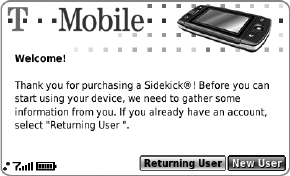
-19-
Press the trackball to select the New User button and advance
to the next screen. On subsequent screens, select the Next
button to advance.
2 Type your first name and last name.
Use the keyboard to type your First name, then roll the
trackball down to highlight the Last name field. Type your last
name, scroll down to highlight the Next button, then press the
trackball to advance to the next screen.
3 Select a username.
The username you type will become the first part of your
email address (for example, username@example.com).
Before you select a username, read the following:
n Usernames must start with an alphabetic character (A-Z)
and can include numbers (0-9), dashes (-), periods (.), and
underscores (_), but no other punctuation. Although you
can use periods within a username, do not use a period
at the beginning or end of the name, and do not use two
periods (..) in a row.
n Usernames must be at least 2 but no more than 32
characters long.
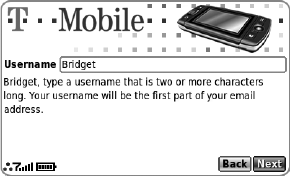
-20-
n Usernames are not case-sensitive. For example, if your
username is “bridget”, you will be authenticated if you sign
in by typing “Bridget”, “BRIDGET”, or any combination of
upper or lowercase letters.
Once you decide on a username, type it in the text box, then
select Next.
4 Select a password.
Select a secure password that follows the rules below:
n Passwords cannot be the same as your username.
n Passwords must contain 4-15 characters, can include
both letters and numbers, but no spaces, single quotes ('),
semicolons (;), backslashes (\), or percent signs (%).
n
For enhanced security, do not choose an actual word
that appears in any language dictionary. Do not choose
a proper name, such as the name of a child, local sports
team, pet’s name, or city of birth. Do not choose adjacent
letters on your keyboard or a sequential or repeating
combination of letters or characters, such as “12345678”,
“222222”, “abcdefg”.
nFor enhanced security, do choose a password that is more
than seven characters long, mixes letters and numerals,
and uses upper- and lower-case letters.
-21-
n Passwords are case-sensitive. For example, if you set
your password to be “Hard2Guess”, then you will not be
authenticated if you sign in by typing “hard2guess”.
Type the password in the text box, then type it again to confirm.
You will see feedback on how secure your password is.
5 Select your time zone.
Open the pop-up menu to see a list of time zones. Select
yours from the list, then select Next.
6 Select a “secret question” and type your answer.
If you ever forget your password, for security purposes,
T-Mobile Customer Care will ask you to provide an answer
to the “secret question” you select on this screen. Press
the trackball to open the Question pop-up menu, scroll to
highlight a question, then press the trackball to select it.
Roll the trackball down to highlight the Answer field, then
type your answer. When finished, select Next to continue.
7 Read and agree to the end-user license agreement.
Before you can finish registration, you must read and agree to
the end-user license agreement. You can read it by selecting
the on-screen View Agreement link or from the Desktop
Interface. Once you read the end-user agreement, select the
Next button to indicate your acceptance and transmit your
registration data.
8 Wait while data transmits.
Wait while the data you entered in the Registration screens
transmits to T-Mobile. The service will check to see if your
username already has been taken. If it has, you will be
offered alternatives. You can select one of these alternatives
or type a different username. Note that if you are out of

-22-
network coverage, you’ll be asked to “try again” to resume
registration.
9 Congratulations!
Once your account has been set up,
you’ll see the
Congratulations screen:
Select the Start button to begin!
Setting Up Your Device
Bluetooth® Technology Setup
Your device supports the Bluetooth wireless technology
Specification 2.0 so you can connect to hands-free devices
(headset and car kit) and any device that can receive a vCard via
Bluetooth (PCs, phones).
To turn on Bluetooth features and open the Bluetooth settings, do
the following:
1 Press JUMP to go to the Jump screen. Press MENU to open
the menu, then select Bluetooth. The submenu opens.
2 From this submenu you can do the following:

-23-
Pairing Displays a list of available Bluetooth devices with
which you can pair.
My Device Rename your device (as it appears to others)
and select an option requiring that others authenticate
before connecting to your device. You can also request that
the device automatically try the PINs 0000 and 1234 when
authenticating with other devices.
For maximum privacy and security, make sure you select
the Require authentication check box.
Visibility and Bluetooth On/Off Bluetooth features are “off”
by default; to select a the visibility option, you must first Turn
Bluetooth On from the menu. Once Bluetooth features are on,
select from: Always Visible (if you are actively using Bluetooth
devices), Visible for 60sec (to exchange a vCard quickly), and
Never Visible (prevents others from sending you vCards or
pairing with you).
Send My vCard If you have set “My vCard” in the Address
Book, you can send your vCard quickly to another Bluetooth
device by selecting this option or by using the shortcut MENU
+ Y. Read more in “Set and Send My vCard” on page 56.
3 With Bluetooth features on, you can also use a hands-free
headset or car kit to place and receive phone calls from your
device. Read more in “Bluetooth Hands-Free Headset or Car
Kit” on page 10.
Backgrounds
You can customize the backgrounds that appear on the
application splash screens. In addition to the backgrounds that
come by default with your device, you can download “themes”
from the Catalog and assign them as backgrounds:

-24-
1 Press JUMP to go to the Jump screen. Press MENU then
select Backgrounds.
2 The submenu opens to display a list of available backgrounds.
Your current selection is marked with a bullet and appears
dimmed. If you have downloaded background themes from
the Catalog, they will appear at the top of the list.
3 Select your choice with the trackball.
Font Size
By default, the text on your device appears in a “Medium” size
font, but you can change this size:
1 Press JUMP to go to the Jump screen. Press MENU to open
the menu, then select Settings > Font Size.
2 Select the Font Size pop-up menu and choose from Small,
Medium, or Large.
3 Press DONE to save your font size setting. It will take a few
moments for the font size to change.
This font size setting does not affect the text size on pages
viewed with the Web Browser.
Backlighting
As long as you are actively using your device, the backlight will
stay on. After you stop using your device, the backlight will stay
on for 15 seconds, but you can change this setting:
1 Press JUMP to go to the Jump screen. Press MENU then
select Settings > Battery & Display.
2 In the Display Backlight group box, open the Dim after pop-
up menu and select a timeout option, up to five minutes. The
lower the time, the more battery power you will conserve.

-25-
3 By default, the Use ambient light sensor check box is
selected. This conserves battery power and means when
there is enough light in the environment, the backlight will
dim automatically.
Key Guard Mode
You can “lock” your device controls by entering key guard mode:
1 Press JUMP to go to the Jump screen. Press MENU to
open the menu, scroll to highlight Key Guard, then press
the trackball. You can also enter key guard mode quickly by
pressing and holding DONE for two seconds.
2 The control buttons lock and the key guard screen appears.
To turn on the backlight while in key guard or sleep, press
the right shoulder button.
3 To unlock and wake the device, open the screen or press
MENU + DONE . If you have set a privacy code (see next
section), type it at the prompt.
By default, your device is set to enter key guard mode after two
minutes of idle time. You can change this setting from the Jump
Menu > Settings > Key Guard & Security screen.
To prevent display damage, after your device has been in key
guard mode for five
minutes, the screen will go black (the device
is in “sleep mode”). To wake your device, press any key or open the
screen.
To learn what the blinking trackball colors mean during
sleep mode, read “Trackball light indicators” on page 31.

-26-
Device Privacy Code
If you want to secure your device from unauthorized access once
your device has gone into key guard mode, you must set up a
privacy code:
1 Press JUMP to go to the Jump screen. Press MENU then
select Settings > Key Guard & Security.
2 Scroll down to the Privacy Lock group box. Highlight
, then press the trackball to select it.
3 Enter a three-digit code using the keyboard or the number
pop-up menu:
At the prompt, re-enter your code to verify.
4 A “New Combination Enabled” message appears. Select OK.
5 Press DONE to save your settings and return to the Jump
screen.
You can still make emergency calls from the key guard
screen, even if privacy code is enabled, by opening the display
then pressing MENU + JUMP .
Sound Profiles
Each sound profile defines the volume of rings, reminders, and
system sounds. You can have up to eight profiles; six editable
profiles are provided by default. To create a new or modify an
existing sound profile, press JUMP , then press MENU and
select Settings > Sound Profiles. From the Sound Profiles screen
you can also set the behavior of pending alerts and reminders,
and schedule sound profiles.

-27-
To change the sound profile currently in effect, read “Volume
Controls” on page 12.
Application Customization
You can set application-specific preferences using the Settings
screens found within the applications. Some of application
settings you can customize include:
n Set your favorite Web home page (Web Browser)
n
Select Caller ID icons or photos (Phone/Address Book)
n Create your own categories and labels for identifying contact
information (Address Book)
n Set different ringtones for callers (Phone/Address Book)
If you see a musical note next to a menu item, you’ll
know that’s where you customize that application’s ringtone
setting.
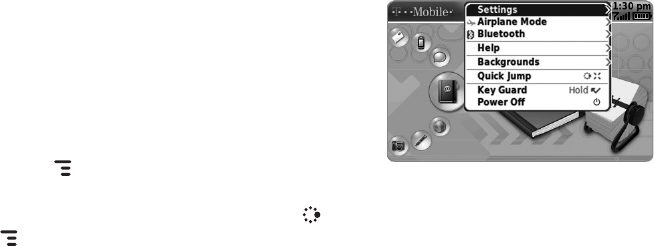
-28-
The Device Interface
The Jump Screen
The Jump screen is your entry point to all device applications.
Application selections are arranged on the left-side of the screen
in a “ring”. Some applications are grouped into a second-level
ring. If you press MENU while on the Jump screen, you’ll have
access to device-wide settings and controls:
1 Go to the Jump screen from any screen by pressing JUMP .
2 Press MENU from the Jump screen to open the Jump screen
menu:
3 To select an application, scroll through the “ring” of
application icons. When the application or application folder
you want is highlighted, press the trackball once to open that
application or to enter the second-level application ring.

-29-
Menus
Almost every screen on your device has a set of actions you can
take while on that screen. These actions are listed in a floating
window, which you open by pressing the Menu button
MENU . Menu items with submenus are noted with a right-
pointing arrowhead. The Phone Settings submenu is shown
expanded below.
Frequently-used menu items also have keyboard shortcuts that
use the Menu button plus a shortcut key. Take a look at the
menu shown on the previous page. To create a new speed dial
shortcut, you could press MENU + N rather than opening the
menu and selecting New Speed Dial with the trackball.
Quick Jump
To jump to a pending message or an application you’ve used
recently, open the Quick Jump menu by pressing JUMP +
CANCEL . Select from Recent (recently-used applications) or
Pending (messages you haven’t read yet). Note that you can use
the shortcuts listed to go directly to that application or message.
Pressing JUMP + 0 will always open the latest unread message.
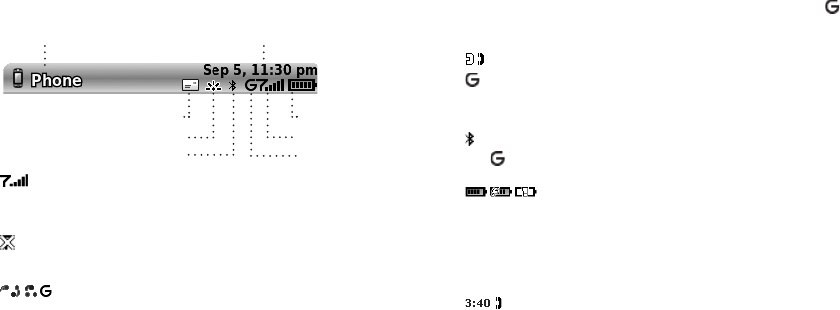
-30-
Indicators
Bluetooth On
Screen Title
Battery Level
Wireless Signal Strength
Date and Time
Service Connectivity
New Message Notification (Email)
Sound Profile Setting
Wireless signal strength indicator The number of signal
bands showing to the right of the radio tower icon represents the
strength of the signal at your current location.
If you see an X flashing over the radio tower icon, you’ve
temporarily lost network connection and can make no calls.
Service connectivity indicators One dot = device is
connecting to the GPRS/EDGE network; two dots = getting IP
address; three dots = connecting to the data service; = fully
connected to the data service.
GSM (Phone) service only A phone icon in the place of the
means you are using (or only have access to) GSM phone
service. If you have a call in progress you’ll also see a timer. If the
phone icon is hollow, you can only make emergency phone calls.
Bluetooth indicator When you see this icon just to the left of
the , Bluetooth features are available.
Battery level indicators The number of bars showing
in the battery icon represents the charge remaining in the
battery. While charging, a lightning bolt appears, and when your
battery is almost fully discharged, a “!” appears.
Phone call indicators
A timer appears when you have a call in progress; in
the example, call time elapsed is 3 mins, 40 secs. Note that the
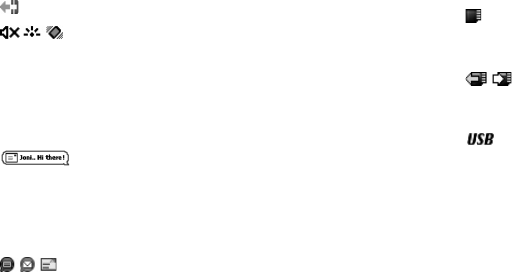
-31-
phone icon blinks. If you have two calls active, the time displayed
is for the foreground call.
Call forwarding is turned on. Your phone will not ring.
Sound Profile setting When you have selected a
sound profile that has sound turned off, the title bar will indicate
whether you have flashing lights or vibration set for alerts or
notifications. From left to right, the icons indicate: totally silent
(no sound, no flashing lights, no vibration), flashing lights only,
and vibration only.
Communication services notifications When you
receive a new email, text, IM, MMS, or voice mail message,
or when a Web page has finished loading, you’ll see a visual
“balloon” notification move across the title bar, while you’re in any
application except games.
Until you check your new message, you’ll see the
appropriate icon in the title bar as a reminder. The examples
shown to the left illustrate a pending picture message, text
message, and email message.
Memory card activity indicator When data is being written
to or from your memory card, you will see this icon flashing in the
title bar, just to the left of the date.
When you are inserting or ejecting the card, you will see
the memory card icon with an arrow; the arrow points left when
inserting, right when ejecting.
USB connector icon When your device is connected to
your computer using the USB port, you will see this icon in the
title bar, just to the left of the date. Note that when your device is
attached to your computer via USB, you cannot view the contents
of your memory card from your device.
Trackball light indicators During device sleep, the trackball will
blink a color: blue = pending message, green = normal sleep,
red = low battery.

-32-
Type and Edit Text
It’s easy to type and edit text using the keyboard and the
advanced text editing features described below.
Navigate in Text Boxes
Use the control buttons and keyboard to navigate within a text box:
n Move character-by-character - Press the D-Pad or roll the
trackball left/right.
n Jump to the beginning/end of a word, press ALT + D-Pad or
trackball left/right.
n
To jump to the beginning/end of a line, press MENU +
trackball left/right.
nTo jump to the beginning/end of text in a text box, to jump to
the top/bottom of a text box, press MENU + or .
Delete Text
nTo delete a character to the left of the cursor, press DEL .
n
To delete a character to the right of the cursor, press
SHIFT +
DEL .
nTo delete all the characters on one line, press ALT + .
Cut, Copy, Paste, Undo
To cut, copy, or paste text you have typed, do the following:
1 Position your text cursor next to the text you want to cut or
copy. (Use the D-Pad or trackball to position the text cursor.)
2 Hold down the SHIFT key while pressing the D-Pad or
trackball in a direction. As you select text, it is shown
highlighted. (To de-select, release the SHIFT key and press
the D-Pad or trackball.)
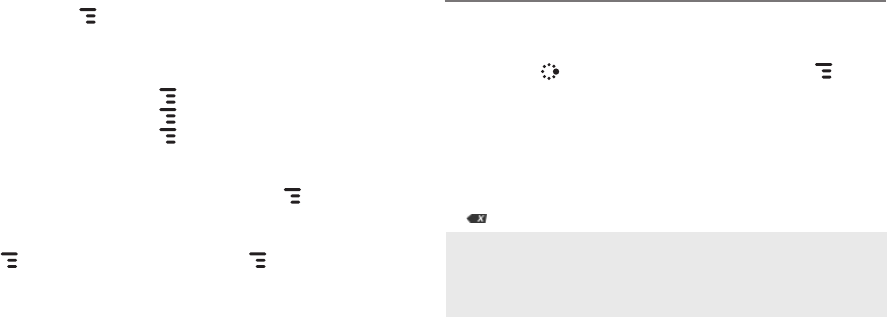
-33-
3 Press MENU and select Edit Text to open the Edit Text
submenu, or simply press and hold the trackball to open
the Edit Text context menu. Select the operation you want to
perform on the selected text. Note the standard shortcuts:
nCut MENU + X
nCopy MENU + C
nSelect All MENU + A
4 Paste text that you have copied (or cut) into any text box in
any application. Position your cursor where you want to paste
the text, then use the Paste shortcut MENU + V. The device
clipboard only stores one set of copied or cut text at a time.
5 If you make a text edit and want to undo it, simply press MENU
+ Z. To redo an undo, press MENU + SHIFT + Z.
AutoText
Use the AutoText feature to type text quickly and accurately:
1 Press JUMP to go to the Jump screen. Press MENU to
open the menu, then select Settings > AutoText. The AutoText
screen appears.
2 The screen offers automatic formatting and word replacement
options. Open the menu to discard or create AutoText rules.
Note that when typing, words are replaced only after you
press the spacebar. To undo a word replacement, press DEL
to delete the space.
Quickly insert your email address, date, time, or phone
number by using these AutoText rules: @email to insert your
email address, @ld to insert the current day and date, @lt to
insert the current time, @phone to insert your phone number.

-34-
Type Special Unicode Characters
To type special Unicode characters in any text box, press the
SYM key. The Special Character selector opens.
Use the D-Pad or trackball to navigate through the list: left-right to
flip through the Favorites, Recent, alphabet, and symbol sets; up-
down to select specific characters. Press the trackball to insert a
highlighted character.
Here are some useful tips when using the Special Character
selector:
nWith the selector open, you can show the same characters
capitalized by pressing Shift + the character (like “a”). Toggle
back to lowercase by pressing the letter again.
n To see all special characters, select All (at the bottom of the
selector) or use the menu shortcut MENU + A, and the grid
expands.
n To open a character set for a specific letter, press SYM + the
letter.
n To type a character using its Unicode value (hover over a
selection in the selector for two seconds to see the Unicode),
press SYM + Spacebar (press the keys simultaneously), then
type the four-character Unicode value.

-35-
The Desktop Interface
The data you store in your device’s Email, To Do, Calendar,
Address Book, Notes, and Camera applications is also available
for viewing or editing on the Web from any computer connected
to the Internet. Information in your Sidekick account is stored
on servers in a data center with enhanced security and firewall
features.
To reach the Desktop Interface, use the Web navigation and sign-
in instructions provided in the Start Guide, included in the box.
Once you’ve signed in, your Jump page will open. Use the Jump
page navigation buttons to open the various applications:
n Open the online Help page by clicking the Help link.
n Import existing contacts from the Address Book > Import
page; import existing Calendar events from the Calendar >
Import page.
n Synchronize your Sidekick Address Book, Calendar, and
To Do items with Microsoft Outlook by downloading the
Intellisync application: click Settings (next to the Help link
on the top bar), then click the Sync tab and simply follow the
instructions.
n Change your default language or time zone by clicking
Settings.